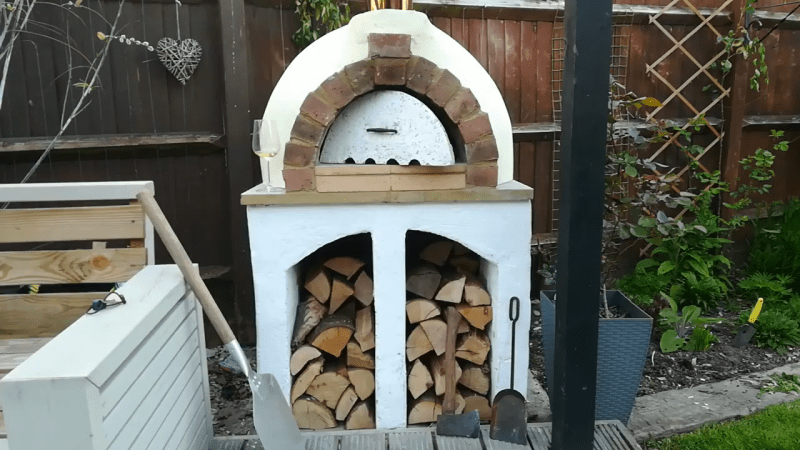See, this is what happens when pizza lovers follow their dreams. It probably started innocently enough for [phammy57]—he got a pizza stone, then maybe one of those big rocking pizza cutters. Maybe he even learned how to toss the dough high in the air. But every time [phammy57] slid one of those homemade pies into the electric oven, the nagging feeling grew a little stronger. Eventually, he gave in to making pizza the way it’s supposed to be made, and built a wood-fired oven.
The most intriguing thing about this build is also the most important: this pizza preparer pivots on a gym ball, which served as the base for forming the oven. To do this, [phammy57] pushed the ball halfway through a hole in a big piece of plywood, effectively creating the world’s largest Pogo Bal (remember those?). Then he applied plastic wrap to the ball as a mold release, and laid down a thick mixture of vermiculite, cement, and water.
[phammy57] built the base from lightweight blocks, sculpting a nice arch for the top of the wood storage area. Once the dome was fastened to the base with the opening cut and outlined with brick, he cut a vent hole and built the chimney. Finally, it was time to add insulating blanket material, chicken wire, more vermiculite, and coat of plaster to finish. Take a brief look inside after the break.
It’s a long process of building, curing, and burning in, but the end result looks fantastic. We bet it pizzas like a champ, too. Probably gives this 45-second pizza oven a run for its money.
[Ed Note: If you’re still having trouble parsing the title, try it out with “build” as a noun and “exercises” as a verb.]















Nice build! Just wondering could the vermiculite be replaced with expanded clay (LECA)?
I couldn’t remember where I knew the name from, so googled it (it’s used in potting plants to allow for more drainage.
Then i saw this “Vermiculite is a hydrous phyllosilicate mineral. It undergoes significant expansion when heated.”.
I’m wondering how much heating it needs to cause it to expand, and will that be an issue?
Pretty sure the vermiculite we normally encounter has already *been* expanded through heating (hence its utility as insulation).
Great detailed build! I picked up a beach ball and looks like the same size ball from the Goodwill last year for the furnace/kiln/forge project. I originally got the idea from a magazine article to build a knife making forge. I bought a large bag of course size perlite from Home Depot for my mix. The more I think about this project… man…, another reason I’m working on the welders and might be going on I started gathering free or cost effective resources for almost 2 yrs ago now the more I think about. Anywho… I thought for the high temp applications perlite and silica glass are better for the design. I am liking the use of the ceramic fabric too.
nothing special in cooking a pizza in 45 secs. a proper oven, properly warmed up, cooks a pizza in a minute or less
i ran a pizzeria, thats why i know.
but i do my pizzas in the electric oven. a real brick oven must be started several hours before, in order to be hot enough. we used to start it at least 24 hrs before, after a holiday interruption. or more.
A few advices on using this kind of ovens:
1) Start slow with the fire, unless you use the oven daily and it never cools down entirely.
2) It takes up to 2 hours to heat the oven, when the bricks inside the oven ceiling turn white-ish the oven is ready for pizza backing. Move burning wood and ashes on one side of the oven and clean the floor.
3) A wet cloth is fine to clean the oven’s heated floor. Lots of water, on the long term, will instead damage the bricks.
4) Once the fire is gone and the oven starts cooling down it can be used to bake bread, cakes, and later on to slow cook meat. But this needs some experimentation. My grandmother was very good at it, but she grow up in an age when electric ovens were a rare luxury.